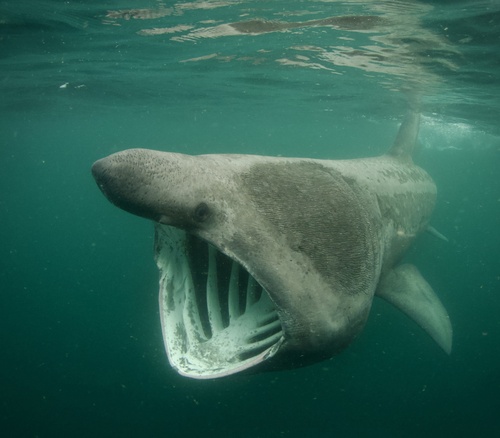
Basking Shark
The Bluefin Tuna (Thunnus) encompasses several species of large, powerful, and highly migratory fish belonging to the Scombridae family. Renowned for their incredible speed, size, and commercial value. These apex predators play a crucial role in the marine ecosystem.
20 50 years
Lifespan
600 - 1200 cm
Length
Vulnerable
Conservation Status
5 km/h
Swimming speed
Filter Feeding, Planktivorous
Diet
Highly Migratory, Seasonal Migration
Migration
Appearance Overview
The Bluefin Tuna is renowned for its sleek, torpedo-shaped body, perfectly adapted for speed and endurance in the water.
Coloration
Dark metallic blue on top with a silvery underside
Fins
Two dorsal fins, with the second being taller than the first
Body shape
Torpedo-like, streamlined for efficient swimming
Scales
Small and cycloid (smooth-edged)
Length
Up to 10 feet (3 meters) commonly, but can reach up to 13 feet (4 meters).
Weight
Typically around 550 lbs (250 kg), but can reach over 1,500 lbs (680 kg).
Diet
Carnivorous, feeding on a variety of fish such as herring, mackerel, and sardines, as well as squid and crustaceans.
Feeding Behavior
An opportunistic predator, the Bluefin Tuna uses its incredible speed to chase down prey. They sometimes hunt cooperatively, corralling smaller fish into tighter formations.
Social Behavior
Highly migratory and known to form large schools, particularly during spawning season. They exhibit complex social behaviors, often associating with other tuna species.
Commercial Relevance
Extremely high value, particularly in sushi and sashimi markets, where its fatty flesh is considered a delicacy. This high demand drives significant fishing pressure.
Conservation measures
International fishing quotas, seasonal closures, minimum size limits, and efforts to establish marine protected areas. There's also ongoing research into sustainable aquaculture.
Status
Varies by species: Atlantic Bluefin - Endangered; Pacific Bluefin - Vulnerable; Southern Bluefin - Critically Endangered.
Threats
Overfishing is the primary threat, driven by high market demand. Climate change, affecting prey distribution and spawning grounds, and bycatch in other fisheries also pose significant risks.
Habitat Distribution
Depth Range
Typically found from the surface to depths of 0-900 meters, depending on the species and time of year.
Geographic Range
Atlantic, Pacific, and Southern Oceans. Specific populations have distinct ranges (e.g., Atlantic Bluefin in the North Atlantic and Mediterranean Sea).
Preferred Environment
Temperate and subtropical waters; they prefer open ocean environments but often come closer to shore during migrations.
Reproduction and Life Cycle
Breeding Habits
Spawns in warm waters, with major spawning grounds including the Gulf of Mexico and the Mediterranean Sea. Spawning is seasonal and often involves large aggregations.
Development Stages
Larvae hatch in plankton-rich waters and undergo rapid growth. They transition through several juvenile stages before reaching adulthood.
Fecundity
Highly fecund; females can release millions of eggs per spawning season, although survival rates to adulthood are relatively low.
Maturity Age
Varies by species, but generally matures between 4-8 years. Southern Bluefin Tuna mature later, around 8-12 years.
Faqs about Basking Shark
How long do Bluefin Tuna live?
Bluefin tuna can live up to 40 years, although this varies by species and environmental conditions.
How fast can Bluefin Tuna swim?
Bluefin Tuna are among the fastest fish in the ocean, capable of reaching speeds up to 43 mph (70 km/h) in short bursts.
Are Bluefin Tuna cold-blooded?
No, Bluefin Tuna are warm-blooded, unlike most fish. They have a specialized circulatory system that allows them to maintain a body temperature higher than the surrounding water.
Do Bluefin Tuna migrate?
Yes, they undertake extensive migrations across oceans for feeding and spawning. Some populations travel thousands of miles.
Why is Bluefin Tuna so expensive?
The high fat content, particularly in the belly meat (toro), gives it a rich, buttery flavor that is highly prized in sushi and sashimi.
Copyright @ Nature Style Limited. All Rights Reserved.
 English
English